From beginner Brachypelmas to professional Pokies, Exotics Keeper Magazine discusses eight of the most interesting arachnids in the hobby.
Arachnids, and more specifically spiders, have always held a special place in society. The word ‘arachnophobia’ is certainly one of the more recognisable phobias. However, with the consistent rise in popularity of invertebrate keeping, attitudes are beginning to change. We explore some of the most prolific and interesting arachnida species available in the UK today.
There are no dangerous spiders in the UK, in fact there are only two that could be considered to give a ‘painful’ bite (Steotoda spp.) (Drysdera crocata). Therefore, it is no wonder that a study in 1991 found that most cases of arachnophobia relate to no previous trauma whatsoever. Subsequent studies bounce ideas between environmental factors and a defence mechanism passed on from ancestors.
With consistent demonisation from mainstream media, the vibrant spider-keeping hobby that exists today owes much of its success to the maverick importers of the 80s. Since tarantulas became a staple species for zoos and educational facilities, national consensus began to change. In fact, several tarantula species are very docile. Their safe-to-observe behaviours gave new generations the opportunity to experience the true nature of these remarkable animals.
Of course, the already converted experts can get a lot of joy from keeping spiders that are less safe, but truly awesome. Whether it is their huge size or obscure feeding habits, the traits which some fear, can often ignite a deep passion in those already enthralled arachnophiles.
Brilliant Beginner Tarantulas
Mexican red knee tarantula
(Brachypelma smithi)
The Mexican red knee tarantulas (Brachypelma smithi and B. hamorii) are some of the most iconic species of tarantula, easily identifiable by their bright orange ‘knees’. Originally from the southern state of Guerrero and the pacific coast of Mexico respectively, these species occupy a variety of habitats. Although most found in semi-arid scrublands, these species can occupy deserts and tropical deciduous forests too. Being ambush predators, adults will occupy burrows in rocky environments with substrate covered silk surrounding the entrance. Adults range in size from 12.7-14cm and have a famously docile temperament, contributing to their huge popularity in the pet trade.
Despite its hardy tolerance and popularity in the pet trade, B. hamorii is classed as vulnerable on the IUCN redlist. The increased demand for avocados, as well as lime, mango and melon farming has a significant role to play in the demise of this species. New roads linking farmland to the international port of Manzanillo also cause significant mortalities during mating season.
Mating occurs at the female’s burrow. The male will weave a web where he deposits his sperm before a delicate (but deceivingly rough) process involves the male transferring the sperm into the female’s opisthosoma. Although never observed in the wild, captive females can kill their smaller male counterparts after mating.
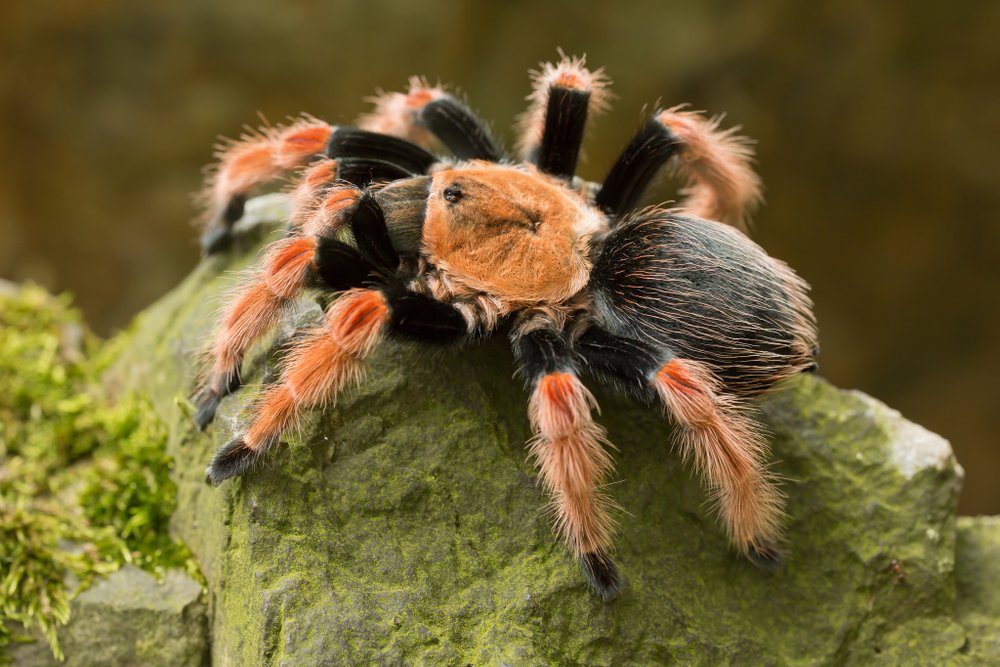
Chilean rose tarantula
(Grammostola rosea)
Praised by educational institutions the world over, the Chilean rose is the perfect introduction to tarantulas and responsible for changing attitudes of arachnophobes everywhere. Although this species can get quite ‘moody’ if handled excessively, they are typically very docile in nature making them a brilliant educational resource and first pet spider.
As the name suggests, these arachnids are from South America ranging from Chile to Argentina. They are also one of the most readily available species in the hobby. This is likely because of the huge numbers of exports from Chile in the 1980s, which has consequently led to a great number of successful captive breeding projects. Two colour phases of this spider exist, one exhibits a pink carapace, while the other has red hairs across its entire body, contributing to the coining of its common name.
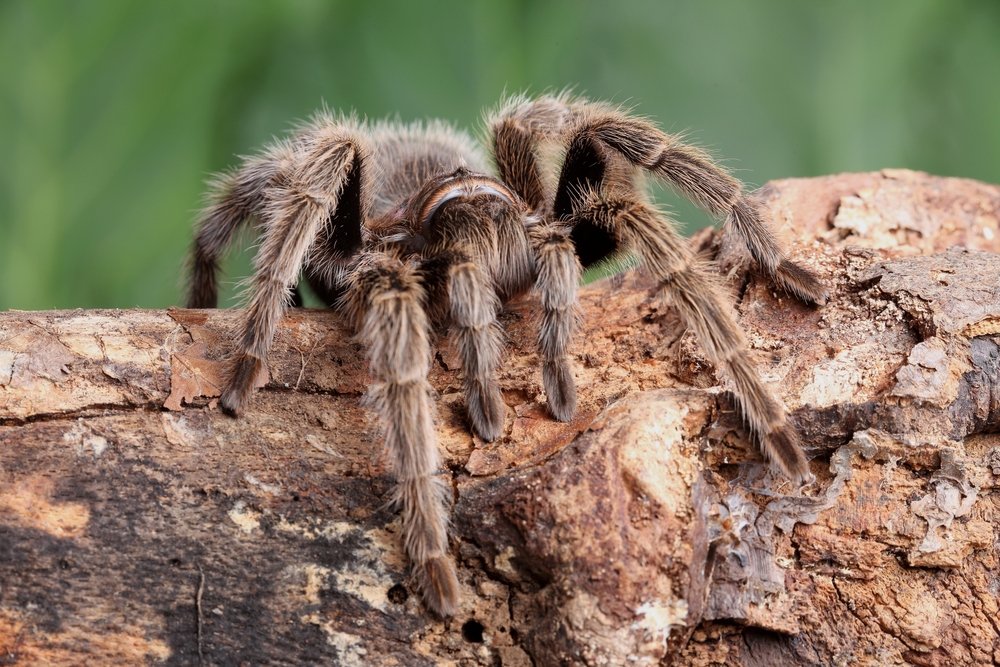
Caring for the Mexican Red Knee and the Chilean Rose
Both the Chilean Rose and the Mexican red knee require relatively basic care. The Mexican red knee is a burrowing species, whereas Chilean rose’s are terrestrial and notorious tank re-decorators. A 30x30x30 terrarium would suit both but a larger enclosure would benefit the Chilean rose. Being desert species, they can both tolerate a broad temperature range. Between 24°C and 27°C is ideal with a low humidity of 65-75%, never dropping below 55%. A comfortable environment for the keeper is likely to be comfortable for the spider, but a heat mat with thermostat can assist in this. A shallow water dish should be provided for both species and can assist in maintaining a suitable humidity.

Curly Hair Tarantula
(Tliltocatl albopilosum)
The curly hair (Tliltocatl albopilosum) has earnt its title as the perfect beginner spider due to several reasons. Firstly, it’s the most readily available species in the UK, which also gives it the title of the most inexpensive species in the market. The curly hair typically exhibits a very docile nature, making them an accessible species for all invertebrate keepers.
Despite being native to Nicaragua and Costa Rica, Tliltocatl albopilosum was previously referred to as the Honduran curly hair as they strongly resemble another species which was imported from Honduras during the 80s.
The original curly hair described in 1980 had white setae (a term used to describe a tarantula’s hairs). However, almost all curly hairs in the trade today have golden hairs. This species was also previously referred to as Brachypelma albopilosum, belonging to the Brachypelma genus. However, since 2019, the genus has been broken down into Brachypelma and Tliltocatl due to morphological differences.
Although predominantly terrestrial, this species does enjoy burrowing to avoid the harsh central American heat. This species inhabits seasonal tropical forest environments where it can often be found close to permanent waterways. Because of this, good husbandry requires a little more effort than other species. Temperatures should be maintained between 25°C and 29°C during the daytime, with a relative humidity of 65-75% between January and April and 75-85% for the rest of the year.
The curly hair can reach leg spans of up to 15.5cm and exhibits many of the traits desirable in a pet tarantula. They are famously docile, active hunters and relatively easy to care for. The biggest mistake owners make with this species is to use dry substrate which does not meet the spider’s humidity requirements.

Stunning Spiders for the Experienced Keeper
Those that have kept spiders for numerous years and searching to develop their collection know there is no shortage of truly awesome arachnids in the hobby. Many of these species should never be handled, enticing an audience that prefers to observe the arachnids for the remarkable predators they are. Care requirements at this stage require more precision and a greater understanding of the animal’s wild needs. Arboreal species are often quicker, making them better suited to an expert. Equally, the ‘old world’ genus’ of tarantulas that exhibit bright colouration and catch the eye of the arachnid enthusiast often have more potent venom, again, making them better suited to an expert.
Goliath Bird Eating Spider
(Theraphosa blondi)
The goliath bird eater (Theraphosa blondi) is the largest spider in the world by mass and body length. This giant from the Amazon was first described by French explorers in 1804 and inhabits swamp areas deep within the rainforest, fuelling its mysterious infamy. Despite the ominous name, T. blondi rarely feeds on birds and instead preys on invertebrates, reptiles and small mammals. However, it is thought that the 18th Century explorers that discovered the species, witnessed this spider eating a hummingbird and this image was immortalised in Victorian paintings.
The goliath bird eater has fangs measuring an impressive 6.5cm. Needless to say, a bite from this species is likely to cause considerable pain. The urticating hairs this spider uses as a defence mechanism can also cause serious irritations. Being a relatively skittish and aggressive spider, this species should only be kept by experts who have no desire to handle the animal.
Due to the goliath’s size, a minimum terrarium size of 60 x 45 x 45 is required with thick layers of moist substrate to ensure high humidity levels. Goliath bird eaters also appear to benefit from a well decorated enclosure. A cork hide is crucial, but plants can often stimulate explorative activity. Unlike other arachnids that can get their water from prey items, goliaths require a shallow water dish in their enclosure.
Almost all tarantulas benefit from a varied diet in captivity. Goliaths should be fed on predominantly on crickets and locust but can also be fed the occasional pinkie mouse.
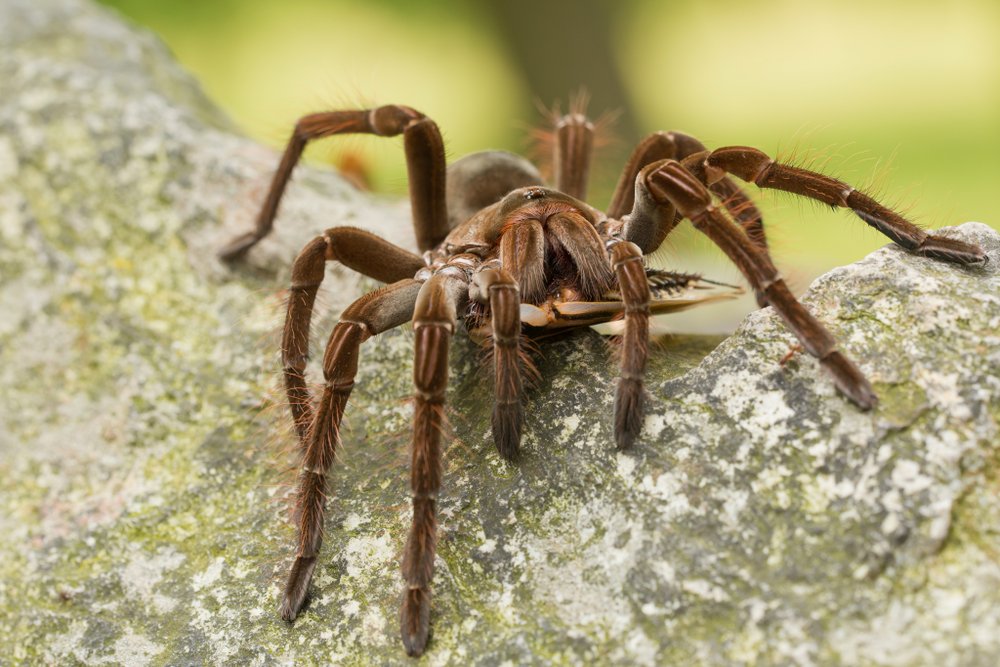
Gooty Sapphire Ornamental Tarantula
(Poecilotheria metallica)
Stunningly vibrant, critically endangered and dangerously venomous, Poecilotheria metallica is arguably the most interesting tarantula species on the planet. Otherwise known as the Peacock spider, this Indian species was discovered in 1899 by Reginald Pocock.
The Gooty sapphire ornamental tarantula originates from Andhra Pradesh forest around 250km from Gooty. The specimen which coined the common name was found in a timber train yard and likely travelled the distance through human intervention. Because P. metallica is extant in just a 100km radius in South central India, this species faces threats from deforestation, logging, illegal exports and military exercises.
Although breeding projects from enthusiasts within the hobby have been successful, the Gooty sapphire ornamental does not make a good pet. Their venom, although not lethal, can cause an excruciatingly painful bite which is considered ‘medically serious’.
In captivity, the Gooty sapphire should be treated as an arboreal species. In the wild, this species would typically inhabit tree trunks off the ground. Spiderlings often display terrestrial behaviours such as burrowing but adequate height with a tall cork bark hide should be provided as they grow. A 30x30x45cm terrarium is the minimum size required by an adult female Gooty sapphire, but extra height is often appreciated. Temperatures should be kept between 25°C – 29°C and drop by 5°C at night, while humidity remains between 70% and 80%.
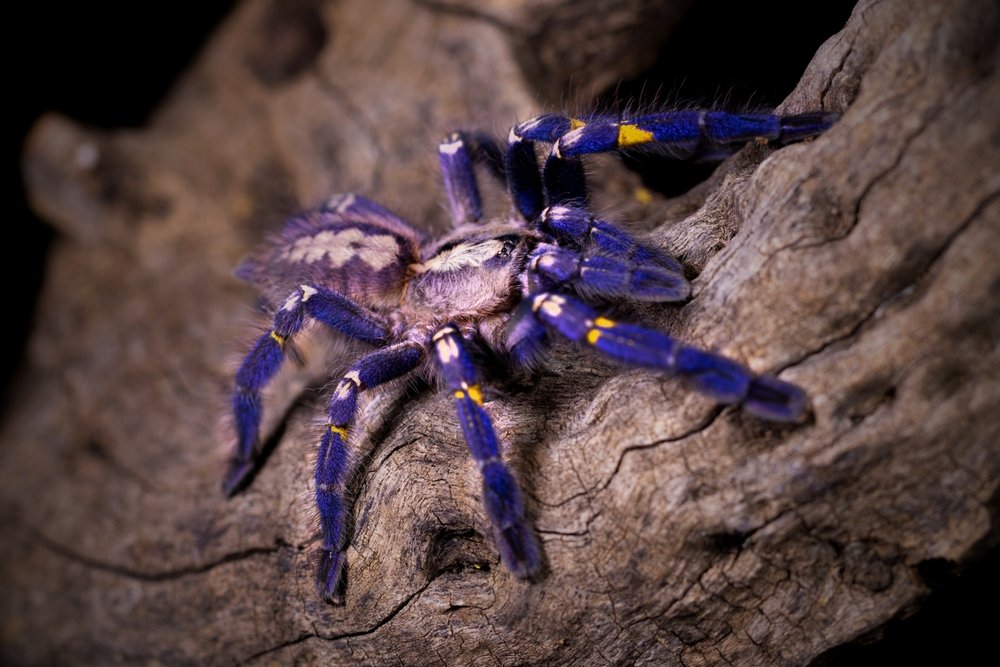
Indian Ornamental Tarantula
(Poecilotheria regalis)
Belonging to the same family as the Gooty sapphire, Poecilotheria regalis shares many of the stunning traits that make these tarantulas so appealing. Also described by Pocock in 1899, this arboreal tarantula displays similar patterns to the Gooty, in shades of black and white. The Indian Ornamental also has an underside of vibrant banana-yellow on the front legs.
Thankfully, this species is much more common than its sapphire cousin. Spread across much larger pockets of central and West India, the IUCN has classified P. regalis as ‘least concern’ suggesting there is no need for dedicated conservation efforts at present. However, recent scientific research into the Yerramalais Forest of the Eastern Ghats suggests that human interference is depleting the natural resources in this region for many species (Khaleel Basha et al 2014) which creates a much bleaker picture for the Poecilotheria genus.
In captivity, caring for P. regalis is very similar to caring for P. metallica as they inhabit the same tropical forests. However, the Indian ornamental is slightly hardier and can easily tolerate humidity up to 95% for some months. Like the Gooty, the Indian Ornamental is typically unproblematic when breeding, making it a readily available species within the industry.
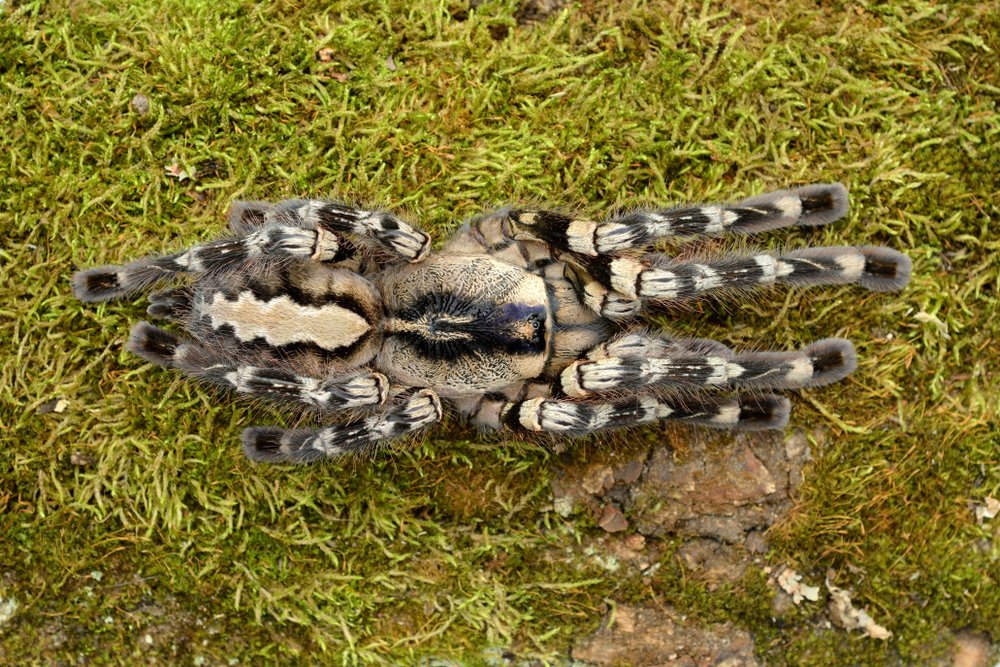
Other Amazing Arachnids
There is a paradox in arachnophobia that omits a huge portion of the Arachnida order. This order also contains scorpions, mites, ticks, harvestmen and solifugaes and ambilygpis. While the concept of a pet ‘tick’ might raise some serious concerns, some members of this group make wonderful pets. Solifugaes such as camel spiders, despite their terrifying appearance, are starting to appear within the hobby. While uropygids such as the tailless whip scorpion (Damon medius) have become a staple species in many pet shops, within a few years.
Emperor or Imperial Scorpion
(Pandinus imperator)
There are few hobbyists that would contest against the emperor scorpion (Pandinus imperator) being the ultimate pet scorpion. Impressively large, reasonably harmless and easy to care for, the emperor scorpion makes an ideal first invertebrate. Emperor scorpions are typically docile, but handling scorpions is advised against. Scorpions are more fragile than they appear, their sting is often likened to that of a bee and they can suffer from stress during handling.
These nocturnal predators hunt at night, using sensory hairs on their body to search for nearby prey. The emperor scorpion inhabits fallen trees and logs in the tropical rainforests of West Africa. This species competes with the giant forest scorpion (Heterometrus swammerdami) for the title of the world’s largest scorpion, with both averaging out around 20cm in length. The giant forest scorpion however, can reach a weight of 56g compared to the emperors 30g, solidifying the current title.
Emperor scorpions should be fed prey items 2 to 3 times a week. However, it is expected that the animal will lose their appetite some weeks before moulting. Emperor scorpions benefit from a temperature gradient in their enclosure from 25°C to 32°C with a drop at night.
Whilst still a common site in zoos and invertebrate collections, a ban on exports and a reasonably limited number of breeding projects has made the emperor scorpion much less available in recent years. Consequently, this affects the price of these animals, which has increased exponentially over the last decade.

Tailless Whip Scorpions
(Damon .spp)
After their 15 minutes of fame in Harry Potter and the Goblet of Fire, tail-less whip scorpions (Damon .spp) have exploded with popularity in the pet trade. These species include D. medius, D. diadema and D. variegatus, which are all found across Africa.
Visually striking, these arachnids display an aesthetic that mirrors both spiders and scorpions, yet they move sideways, much like a crab. Their pedipalps are used to grip onto prey items as they feed. The males have much larger pedipalps than the females.
General care requirements follow a similar trend to most arachnids, with a 24°C-26°C day time temperature. Different species can require slightly cooler temperatures, but these are rarely available in the UK pet trade. Humidity should be kept at 80% but air flow is absolutely crucial to keeping a healthy tailless whip scorpion. Unlike many tarantulas, Damon spp. are fragile and susceptible to illness without strong ventilation.
This fragility also extends to their moulting habits. Hard stone backgrounds can wear the tailless whip scorpion’s claws down, causing them to fall to the enclosure floor during moulting. As Damon .spp rarely venture onto substrate, a 2” layer of chemical free compost, coir and sphagnum most is sufficient to hold moisture.
